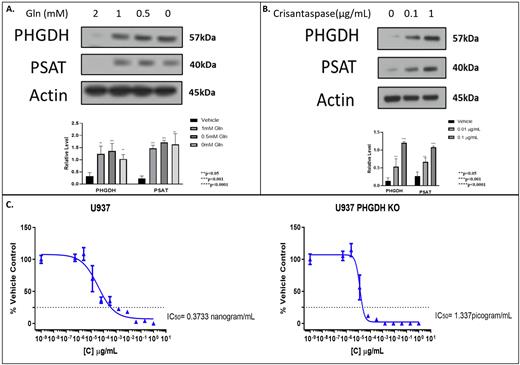Abstract
Background: Metabolic reprogramming contributes to tumor development and introduces metabolic liabilities that can be exploited to treat cancer. Glutamine (Gln) is the most abundant amino acid intracellularly and in the plasma. Gln depletion has emerged as a therapeutic approach for cancers that have exhibited a dependence on Gln for survival, including acute myeloid leukemia (AML). Crisantaspase, an Erwinia asparaginase, has demonstrated promising anti-AML activity in preclinical/clinical models through interference with plasma Gln supply; however, residual leukemia burden was shown in vivo following Gln depletion by a crisantaspase. Following treatment with asparaginases in vitro, we observed a consistent increase in serine (Ser). Therefore, we hypothesized that in response to Gln depletion, AML cells upregulate de novo Ser biosynthesis as a compensatory pathway, and the inhibition of this pathway will synergize with Gln depletion to increase AML cell death. To test this, we knocked-out phosphoglycerate dehydrogenase (PHGDH), a key enzyme in Ser biosynthesis, in AML cell lines (MOLM-14 and U937) by CRISPR-cas9 and examined the response of the knockout lines to Gln depletion either through Gln withdrawal from the media or crisantaspase treatment.
Methods: Single-cell cloning methods were used on bulk populations of PHGDH CRISPR-cas9 knockout cells to characterize positive knockouts and clones were further confirmed by Sangar sequencing. The impact of Gln depletion and PHGDH knockout on AML cell proliferation/viability was assessed using water soluble tetrazolium (WST-1), trypan blue, and measurement of Lactate Dehydrogenase (LDH) release. Immunoblotting was used to examine the expression of the Ser biosynthesis proteins, PHGDH and phosphoserine aminotransferase (PSAT), and glutathione (GSH) levels were measured via a luminescent-based assay.
Results: We determined that short-acting crisantaspase (Rylaze) inhibited the proliferation of several AML cell lines with pharmacologically relevant IC50 values ranging from 0.001 to 0.08 µg/mL. Similarly, decreasing the concentration of Gln in the media resulted in a dose-dependent decrease in cell proliferation/growth, confirming AML sensitivity to Gln depletion. Protein expression of PHGDH and PSAT was upregulated following Gln withdrawal from the media (Fig. 1A) as well as following crisantaspase treatment (Fig. 1B). PHGDH knockout AML cells were significantly more sensitive to crisantaspase, yielding IC50 values ranging from 1.34 to 6.59 picogram/mL, ~250-fold lower compared to the parental lines (Fig. 1C). Gln depletion through crisantaspase treatment or withdrawal from the media decreased GSH levels and increased LDH release, both of which were further enhanced by PHGDH knockout. Taken together, these results support dual targeting of Gln and Ser metabolism in AML. Preliminary testing of an NAD-dependent cell permeable PHGDH competitive inhibitor prodrug (Ethyl 2-{4-[(1S)-1-[(4,5-dichloro-1,6-dimethyl-1H-indol-2-yl)formamido]-2-hydroxyethyl]benzenesulfonyl}acetate) demonstrated an inhibition of AML cell proliferation in multiple cell lines, with IC50 concentrations ranging between 1.2 to 2.3 µM.
Conclusion: Simultaneous targeting of Ser and Gln metabolism for AML treatment shows promising results in vitro with great potential for translation into clinical practice with clinically available asparaginases, and other glutamine modulators. Ongoing work is focused on the design of a more potent pharmacologic inhibitor of PHGDH to combine with crisantaspase as a novel treatment approach for AML.
Disclosures
Sintim:KinaRx, Inc.: Other: Founder/Scientific Advisor . Emadi:Genentech: Membership on an entity's Board of Directors or advisory committees; Secura Bio: Consultancy; KinaRx, Inc.: Other: Founder and Scientific Advisor; Kite Pharma: Consultancy, Membership on an entity's Board of Directors or advisory committees; Amgen: Membership on an entity's Board of Directors or advisory committees, Research Funding; Servier: Membership on an entity's Board of Directors or advisory committees, Research Funding; NewLink Genetics: Research Funding; Jazz Pharmaceuticals: Research Funding.
Author notes
Asterisk with author names denotes non-ASH members.


This feature is available to Subscribers Only
Sign In or Create an Account Close Modal